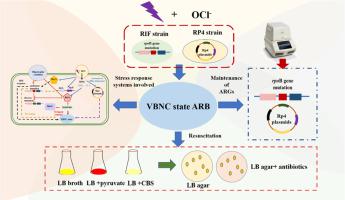当前位置:
X-MOL 学术
›
Water Res.
›
论文详情
Our official English website, www.x-mol.net, welcomes your feedback! (Note: you will need to create a separate account there.)
Viable but non-culturable state formation and resuscitation of different antibiotic-resistant Escherichia coli induced by UV/chlorine
Water Research ( IF 11.4 ) Pub Date : 2024-06-27 , DOI: 10.1016/j.watres.2024.122011 Menglu Zhang , Xuansen Wang , Xiaofeng Deng , Suxia Zheng , Weifang Zhang , Ji-Zheng He , Xin Yu , Mingbao Feng , Chengsong Ye
Water Research ( IF 11.4 ) Pub Date : 2024-06-27 , DOI: 10.1016/j.watres.2024.122011 Menglu Zhang , Xuansen Wang , Xiaofeng Deng , Suxia Zheng , Weifang Zhang , Ji-Zheng He , Xin Yu , Mingbao Feng , Chengsong Ye

|
The presence of "viable but nonculturable" (VBNC) state and bacterial antibiotic resistance (BAR) both pose significant threats to the safety of drinking water. However, limited data was available that explicitly addressed the contribution of bacterial VBNC state in the maintenance and propagation of BAR. Here, the VBNC state induction and resuscitation of two antibiotic-resistant K12 strains, one carrying multidrug-resistant plasmid (RP4 ) and the other with chromosomal mutation (RIF ) were characterized by subjecting them to different doses of UV/chlorine. The results illustrated that the induction, resuscitation, and associated mechanisms of VBNC ARB exhibit variations based on resistance determinants. RP4 exhibited a higher susceptibility to enter VBNC state compared to the RIF ., and most VBNC state and resuscitated RP4 retained original antibiotic resistance. While, reverse mutation in the B gene was observed in VBNC state and recovered RIF strains induced by high doses of UV/chlorine treatment, leading to the loss of rifampicin resistance. According to RT-qPCR results, ARGs conferring efflux pumps appeared to play a more significant role in the VBNC state formation of RP4 and the down-regulation of S gene enhanced the speed at which this plasmid-carrying ARB entered into the dormant state. As to RIF , the induction of VBNC state was supposed to be regulated by the combination of general stress response, SOS response, stringent response, and TA system. Above all, this study highlights that ARB could become VBNC state during UV/chlorine treatments and retain, in some cases, their ability to spread ARGs. Importantly, compared with chromosomal mutation-mediated ARB, both VBNC and resuscitated state ARB that carries multidrug-resistant plasmids poses more serious health risks. Our study provides insights into the relationship between the VBNC state and the propagation of BAR in drinking water systems.
中文翻译:

紫外线/氯诱导不同抗生素耐药大肠杆菌的存活但不可培养状态的形成和复苏
“可行但不可培养”(VBNC)状态和细菌抗生素耐药性(BAR)的存在都对饮用水安全构成重大威胁。然而,明确说明细菌 VBNC 状态在 BAR 维持和繁殖中的贡献的数据有限。在此,通过对两种抗生素耐药 K12 菌株进行 VBNC 状态诱导和复苏,其中一种携带多重耐药质粒 (RP4 ),另一种携带染色体突变 (RIF ),通过将它们置于不同剂量的紫外线/氯下来表征。结果表明,VBNC ARB 的诱导、复苏和相关机制表现出基于耐药决定因素的变化。与RIF相比,RP4表现出更高的进入VBNC状态的敏感性,并且大多数VBNC状态和复苏的RP4保留了原始的抗生素耐药性。同时,在VBNC状态下观察到B基因的回复突变,并恢复了高剂量紫外线/氯处理诱导的RIF菌株,导致利福平耐药性丧失。根据RT-qPCR结果,赋予外排泵的ARG似乎在RP4的VBNC状态形成中发挥更重要的作用,并且S基因的下调增强了该携带质粒的ARB进入休眠状态的速度。对于RIF,VBNC状态的诱导可能是由一般应激反应、SOS反应、严格反应和TA系统的组合来调节的。最重要的是,这项研究强调,ARB 在紫外线/氯处理期间可能会变成 VBNC 状态,并在某些情况下保留其传播 ARG 的能力。 重要的是,与染色体突变介导的ARB相比,携带多重耐药质粒的VBNC和复苏状态ARB都会带来更严重的健康风险。我们的研究深入了解了饮用水系统中 VBNC 状态与 BAR 传播之间的关系。
更新日期:2024-06-27
中文翻译:

紫外线/氯诱导不同抗生素耐药大肠杆菌的存活但不可培养状态的形成和复苏
“可行但不可培养”(VBNC)状态和细菌抗生素耐药性(BAR)的存在都对饮用水安全构成重大威胁。然而,明确说明细菌 VBNC 状态在 BAR 维持和繁殖中的贡献的数据有限。在此,通过对两种抗生素耐药 K12 菌株进行 VBNC 状态诱导和复苏,其中一种携带多重耐药质粒 (RP4 ),另一种携带染色体突变 (RIF ),通过将它们置于不同剂量的紫外线/氯下来表征。结果表明,VBNC ARB 的诱导、复苏和相关机制表现出基于耐药决定因素的变化。与RIF相比,RP4表现出更高的进入VBNC状态的敏感性,并且大多数VBNC状态和复苏的RP4保留了原始的抗生素耐药性。同时,在VBNC状态下观察到B基因的回复突变,并恢复了高剂量紫外线/氯处理诱导的RIF菌株,导致利福平耐药性丧失。根据RT-qPCR结果,赋予外排泵的ARG似乎在RP4的VBNC状态形成中发挥更重要的作用,并且S基因的下调增强了该携带质粒的ARB进入休眠状态的速度。对于RIF,VBNC状态的诱导可能是由一般应激反应、SOS反应、严格反应和TA系统的组合来调节的。最重要的是,这项研究强调,ARB 在紫外线/氯处理期间可能会变成 VBNC 状态,并在某些情况下保留其传播 ARG 的能力。 重要的是,与染色体突变介导的ARB相比,携带多重耐药质粒的VBNC和复苏状态ARB都会带来更严重的健康风险。我们的研究深入了解了饮用水系统中 VBNC 状态与 BAR 传播之间的关系。











































 京公网安备 11010802027423号
京公网安备 11010802027423号